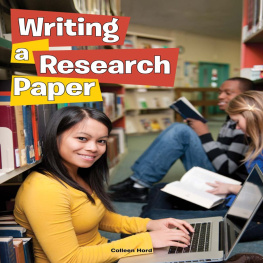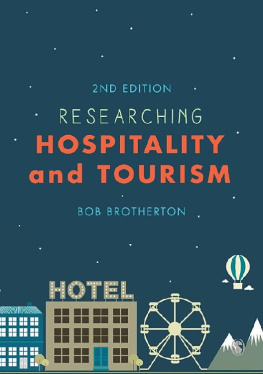Student Research and Report Writing
From Topic Selection to the Complete Paper
Gabe T. Wang and Keumjae Park
This edition first published 2016
2016 John Wiley & Sons Ltd
Registered Office
John Wiley & Sons Ltd, The Atrium, Southern Gate, Chichester, West Sussex, PO19 8SQ, UK
Editorial Offices
350 Main Street, Malden, MA 02148-5020, USA
9600 Garsington Road, Oxford, OX4 2DQ, UK
The Atrium, Southern Gate, Chichester, West Sussex, PO19 8SQ, UK
For details of our global editorial offices, for customer services, and for information about how to apply for permission to reuse the copyright material in this book please see our website at www.wiley.com/wiley-blackwell.
The right of Gabe T. Wang and Keumjae Park to be identified as the authors of this work has been asserted in accordance with the UK Copyright, Designs and Patents Act 1988.
All rights reserved. No part of this publication may be reproduced, stored in a retrieval system, or transmitted, in any form or by any means, electronic, mechanical, photocopying, recording or otherwise, except as permitted by the UK Copyright, Designs and Patents Act 1988, without the prior permission of the publisher.
Wiley also publishes its books in a variety of electronic formats. Some content that appears in print may not be available in electronic books.
Designations used by companies to distinguish their products are often claimed as trademarks. All brand names and product names used in this book are trade names, service marks, trademarks or registered trademarks of their respective owners. The publisher is not associated with any product or vendor mentioned in this book.
Limit of Liability/Disclaimer of Warranty: While the publisher and authors have used their best efforts in preparing this book, they make no representations or warranties with respect to the accuracy or completeness of the contents of this book and specifically disclaim any implied warranties of merchantability or fitness for a particular purpose. It is sold on the understanding that the publisher is not engaged in rendering professional services and neither the publisher nor the author shall be liable for damages arising herefrom. If professional advice or other expert assistance is required, the services of a competent professional should be sought.
Library of Congress Cataloging-in-Publication Data applied for.
Hardback 9781118963906
Paperback 9781118963913
A catalogue record for this book is available from the British Library.
Cover image: Stuart Dee / Getty
Contents
List of Tables
List of Illustrations
Guide
Pages
Acknowledgments
During the process of writing this book, many people have helped us in various ways. We deeply appreciate their help. First, we would like to thank the anonymous reviewers who have provided us with many insightful comments and constructive suggestions. These comments have inspired us in various ways and we have incorporated many of their suggestions in our writing. It is these comments and suggestions that have improved the quality of this book.
Second, we are indebted to several colleagues at William Paterson University of New Jersey, who provide feedback on our manuscript at various stages while we were writing the book. Professor Peter Chen at the Department of Mathematics provided good comments and suggestions for Chapter 9. Anthony Joachim at the Cheng Library offered many valuable suggestions for Chapter 3. We thank Professor Carol Frierson-Campbell of Music Department for her constructive comments on Chapter 1. Special thanks are also extended to Professor Mary Chayko of Rutgers University, and Professor Janet Ruane of Montclair State University. Their reviews of multiple chapters of our manuscript were instrumental in shaping the book the way it is now.
Finally, we would like to thank the wonderful staff at Wiley. Our editor Justin Vaughan has been most supportive and patient throughout the entire process. Our project editor Ben Thatcher has guided us through the final stages of manuscript preparation and the production process. Lisa Sharp has provided help with many administrative issues.
Our deepest gratitude goes to our families for their love and support.
About the Website
The companion website for Student Research and Report Writing: From Topic Selection to the Complete Paper includes a number of resources created by the author that you will find helpful.
Please go to:
www.wiley.com\go\wang\researchreportwriting
For students:
- Links to online video resources
For instructors:
- PowerPoint lecture slides
Chapter 1
Introduction: Start Your Research Journey
If you have picked up this book, you are likely to be a student of the social sciences, business, or education. You may be thinking about original research for a major paper, for an undergraduate seminar class, or for a bachelors or masters thesis. Or you may be in a practicum course in social science research and writing (often called Senior Seminars in many U.S. universities). You probably have already learned about different theories and have taken research methods courses in your discipline. Perhaps, you feel that you know a fair amount about research terminology, but you might not have had practice designing and carrying out original research of your own. Or you may be simply overwhelmed by the magnitude of the work ahead and do not know exactly where to start. You know what you need to produce in the end but are anxious about how to get it done. If this is the case, this book is for you.
Conducting social science research is a journey that requires a step-by-step blueprint and a time-management plan. Most people today rely on a GPS (Global Positioning System) device or internet map services when they drive to unfamiliar locations. We hope this book works as your GPS research guide, a one-stop shop of practical help for you in each step of your research project, from coming up with a research topic to completing the report. Most chapters provide you with exercises corresponding to each research phase, which will help you complete the work effectively, and work out solutions to problems you may have.
What Is Research?
Before you get on the road, lets first talk about the definition of the term which we will use throughout the book. What is research? These days research has become a part of our everyday life. For example, when you ask someone in business about a new product or a new service, he/she may reply, let me research that for you. As a consumer, you do research on a daily basis, whether it is the price of a car, which tablet device to purchase, or opportunities in the job market. In these cases, research refers to gathering available information so that you may make informed choices. The use of the internet has made this practice so common and routine that even children search for toys on the internet and compare various gadgets they can find before asking their parents to buy them.
On other occasions, you may be asked to do formal research that involves more systematic and conscious processes of gathering information, careful evaluation of evidence, and a methodical synthesis of the information gathered. Examples include doing research for term papers in undergraduate and postgraduate courses, writing a thesis to satisfy a requirement of a bachelors or masters degree, or writing scholarly papers for publication or conference presentations. Or at work you may be asked for a market analysis or a needs assessment. The main difference between the casual everyday research you do as a consumer and the more formal research is the extent of the information to be considered and the methods to be employed in analyzing the information. For the everyday research, you may look up a few pieces of information you can easily find on the internet or from a few people around you; but more formal research will require you to examine issues thoroughly and draw careful conclusions. Formal research requires systematic methods of investigation and a critical analysis of evidence to discern credible and not-so-credible knowledge.












